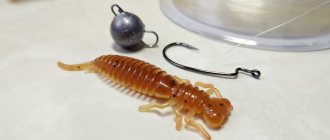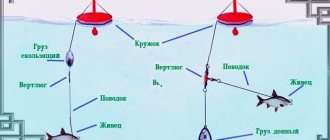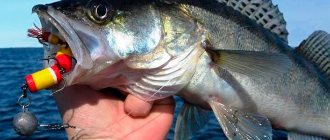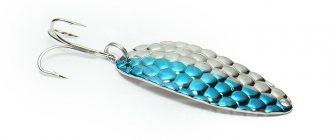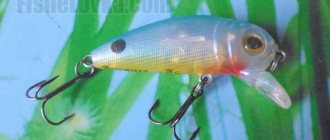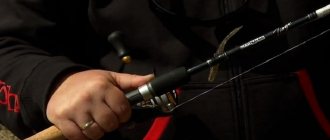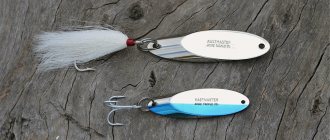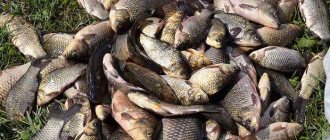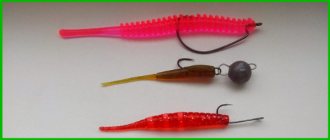What is the tackle?
It is a set of polyurethane foam segments. Which can have different shapes:
- cylinder
- cone
- ball
- cube
These parts are put on treble hooks, connected to each other using winding rings. The classic version of the bait consists of two parts. More complex models are made up of three or four.
The largest tee is installed in the head, the most voluminous part of the mandula. There is a smaller hook in the tail segment. To better attract a predator, it is often equipped with an edge made of the following materials:
- goat hair
- shiny lurex
- Christmas tree tinsel
- bright synthetic threads
Such plumage gives the bait greater mobility during retrieval and makes it as attractive as possible to pike perch. Using a small winding ring, the structure is connected to a Cheburashka weight, the weight of which directly depends on the strength of the current and the depth at the fishing spot.
On lakes and reservoirs, models whose assembled weight is 15–30 g are more often used. On fast, deep-water rivers, heavier options weighing 40–80 g are used.
What kind of fish can you catch?
Polyurethane foam has positive buoyancy, so when it falls to the bottom, the mandula does not lie on the ground, but takes a vertical position in the water, reminding a predator of a feeding fry. Thanks to this feature, it becomes more visible to the fish and can work even in the absence of manipulation by the angler
This design is especially effective when fishing on non-freezing reservoirs in winter, when the fish are not very active. This is ensured by the attractiveness of playing during long pauses. In addition to pike perch, the following can be caught with it:
- pike
- perch
- ide
- asp
- chub
- som
- burbot
Most spinning anglers prefer to make such baits themselves. If you have some experience, you can create models that will be focused on catching a specific type of predator. There are non-hooking versions of the mandula, which are characterized by hooks pressed tightly to the body and work perfectly in conditions of severely snarled water.
Mandula for pike perch
Fishing for pike perch involves frequent casting to the riverbed edge. In this case, it is recommended to use a sinker weighing 40 g. The weight is attached to the mandula. If desired, you can use a heavier weight. Most often, bites occur when the device falls. Being in free flight, the mandula lures the pike perch and provokes it to attack.
During the fall, the bait's body moves and oscillates realistically. Each of the segments on which her body consists creates a coherent and bewitching game. The tasseled ponytail just adds to the colorfulness of this game. As soon as the fish starts to bite, the fisherman feels a couple of pokes in his hand, and the line begins to sag.
Pike perch bite much more often when the mandula falls to the bottom surface. The most important thing is not to be distracted so as not to miss the bite. After the first poke, you should make a powerful hook. If time is lost, the predator will spit out the device and quickly swim away.
The length of the pause between turns of the coil during wiring should reach 3-5 seconds. Depending on the fishing location, you can choose the preferred pause time. As soon as the pause begins, you should begin moving the tip of the rod to ensure a spectacular play of the mandula, which predatory fish cannot resist.
Photos of catchy flowers
Most anglers use mandules for fishing, consisting of two or three segments, since they are quite simple to manufacture and show stable results on any type of reservoir. You should not overload the bait, as this negatively affects the smoothness of its play and negatively affects the quality and quantity of bites. Among the huge variety of models, designs in the following colors are especially popular:
The preferences of pike perch in different bodies of water can differ radically. If orange baits work well on one lake, this does not mean at all that the same palette will be effective on a river flowing nearby. In muddy water, baits of the following colors will catch better:
- red
- orange
- black
- blue
In conditions of low transparency of the aquatic environment, you need to select contrasting color combinations that will make the bait more noticeable to the predator.
In late autumn and winter, when the water is particularly clear, the following combinations work well:
- pink and purple
- green and yellow
- white and blue
When fishing at a depth of over 10 m, where there is a shortage of sunlight, the mandula’s palette does not play a big role. Under such conditions, the predator is guided not by the visual perception of food objects, but by the lateral line organs that react to movement.
Mandula for pike
To catch pike with a spinning rod, you need to use a bait consisting of 3-4 parts. The recommended length of the device reaches 8-15 cm.
The tees must be large enough to eliminate the possibility of it falling out of the wide mouth of a predatory fish during a bite.
For quiet pike hunting, it is best to use polyurethane foam of various shades:
- white;
- black;
- red;
- yellow;
- blue.
The pike mandula can be either plain or painted in several colors at the same time. Experienced fishermen claim that contrasting mandules work most effectively.
Important! The hooks of the bait are open, so it is unacceptable to use it for quiet hunting of predators near snags and thickets of grass. A huge number of hooks will spoil the fishing experience. The person will be busy constantly tying the equipment and installing a new bait.
Using a modern fishing device involves fishing in open water.
The ideal place for such pike fishing would be areas near:
- pit;
- eyebrows;
- braids;
- hills at the bottom of the reservoir.
The presence of a sandy bottom will minimize the risk of snags. If there is no accumulation of algae on a rocky area, you can try fishing with a mandula in this place.
Due to the presence of several body segments in the device, the bait maintains active play in the water surface for a long time.
During the wiring, it is important to pause after the step. The duration of the pause when fishing for pike can reach 15 seconds. A long pause works much more effectively when hunting quietly in the current. Streams of water shake the bait well and revive it.
DIY mandula
Ready-made mandules of various colors, sizes and designs can be purchased at almost any fishing store, but most spinning anglers prefer to make them themselves. This approach allows you to save money and makes it possible to create products that are optimally suited for certain fishing conditions and correspond to the preferences of the predator in a particular reservoir.
What materials are needed
The popularity of the bait is explained not only by its high catchability, but also by the fact that common and cheap materials are used for its manufacture:
- polyurethane foam
- treble hooks
- stainless steel wire with a diameter of 0.4 mm
- small winding rings
- Lurex
The polyurethane foam body of the mandula can be made from beach slippers, a travel rug or a soft children's construction set. Tees and winding rings can be purchased at any fishing store at a very affordable price. Lurex is also easy to find on sale. When creating this bait, you cannot do without waterproof glue.
Manufacturing process
Making it yourself is not very difficult. To do this you will need:
- Cut cylindrical, spherical or cone-shaped blanks from polyurethane foam. It is more convenient to do this using nail scissors or punches, which are metal tubes with a diameter of 1 to 2.5 cm with sharpened edges.
- Glue the resulting elements so that the length of the individual segments is from 2 to 3 cm. Make a longitudinal through hole in each glued segment, which should be located strictly in the center.
- Twist the end of a piece of stainless wire 3–4 cm long to form a small loop.
- Insert the resulting structure into the polyurethane foam blank.
- Form a loop at the other end of the wire.
- Place the resulting structure on the forend of the tee.
- Connect all segments using winding rings.
At the final stage, the rear treble hook is equipped with feathering made of Lurex or other material. This can be done using braided fishing line wrapped around the forend and soaked in superglue. Lures with colored edges are highly effective when the predator is passive.
Rod equipment
Since the mandula is a jig type of bait and is presented exclusively in the bottom layers of water, for fishing with it an appropriate set of gear is used, consisting of several elements:
- fast action spinning rod 2.4 to 3 m long
- spinning reel size 2500–3500
- braided cord with a diameter of 0.12 mm
- leash made of Kevlar wire or guitar string
For mandula fishing, a spinning rod with a fast action is used, which is highly sensitive and allows you to feel all the unevenness of the bottom topography. A rigid rod transfers even light touches of the bait by a predator to the angler’s hand.
For fishing from the shore, a spinning rod with a length of 2.7–3 m is better suited. Such tackle allows you to cast the bait at a distance of up to 90 m from the shore, which is often necessary. When fishing from a boat, there is no need for long casting, so you can use rods about 2.4 m long, which are much easier to manipulate during the process of retrieving and retrieving.
Fishing on a large river with a fast current requires the use of a spinning rod with a test weight of 40 to 80 g. In stagnant bodies of water, the upper limit of the test range is usually limited to 40 g.
A correctly selected reel makes it possible to carry out forced fishing, which in some cases is necessary. The “inertia-free” used for fishing with the jig method should be different:
- small additional number of bearings
- fine tuning of the friction brake
- evenly laying the cord
A small number of bearings gives the reel high traction performance and increases its reliability. Fine-tuning the clutch will allow you to fight large predators and minimize the likelihood of the cord breaking. Uniform laying of the braid contributes to a high casting distance.
The kit includes a braided cord. It has a minimal coefficient of elongation, which allows you to feel the bottom well and any touch of the fish to the bait. The combination of high breaking load and small diameter makes it possible to make long casts.
The use of a metal leash allows you to avoid rapid wear of the final section of the cord, which is constantly in contact with shell rock and sharp edges of stones. This element will also help out when biting a toothy pike. In addition, twists can be made at the ends of a guitar string or Kevlar wire, relieving the spinner from the need to use carabiners and allowing him to quickly change the bait. The leash length is usually 15–20 cm.
How to properly fish for pike perch in the fall and other months
To successfully catch pike perch, a spinning angler must master several types of fishing. There are different ways to present this bait:
- classic "step"
- drawing
- tosses
Classic stepped wiring is the most versatile and works well at any time of the year. It consists of several quick turns of the reel, alternating with pauses, during which the bait begins to fall to the bottom. It is at this moment that predator bites most often occur.
Dragging along the bottom is practiced in those areas of the reservoir where there are sharp drops into depth. The bait is moved very slowly, while furrowing the ground and leaving a trail of turbidity behind it. Short pauses are made every 30–40 cm. During the wiring process, you can slightly move the tip of the rod, giving the mandula additional animation. This method is especially effective when pike perch do not exhibit high feeding activity.
Providing bait with the help of tosses can be effective in the autumn, when the predator begins to eat. This wiring consists of sharp jerks with the tip of the spinning rod, alternating with quick reeling of the sagging cord. The amplitude of the strokes should be about 40 cm. When fishing with this method, the bait creates strong vibrations in the water and attracts active fish from afar.
What are the advantages of bait?
This gear has several significant advantages over classic jig baits. These include:
- Low cost. This is a very important factor, considering that fishing is usually carried out in heavily snag areas, where frequent losses of bait are inevitable.
- Positive buoyancy. This feature allows you to catch passive pike perch, which only reacts to a stationary bait.
- The ability to quickly make it yourself, which significantly reduces the cost of fishing and allows you to make models that are optimally suited for a specific body of water.
It has been noticed that when fishing with a mandula, snags occur much less frequently than when fishing with traditional jig heads. At the same time, the predator detects it much better.
Tackle for mandula fishing
A prerequisite is that the angler has sensitive gear for mandula fishing. The predator most often takes the bait gently. In order not to miss a bite, you should feel every touch.
Test gear for catching predatory fish should be equal to the mass of the bait, but not exceed 25 g. Thin braid can be placed on the gear. The weight of the weight will not particularly affect the performance of the bait, but will help increase the casting distance.
